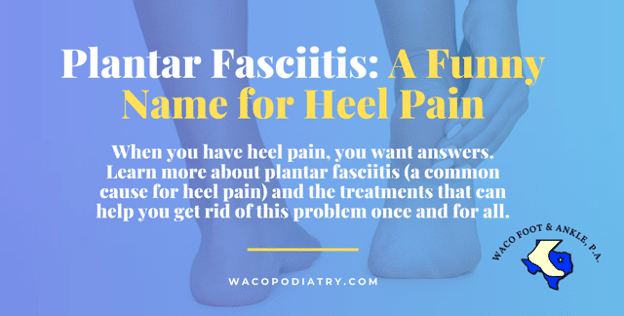Plantar Fasciitis: A Funny Name for Heel Pain
Heel pain is a common complaint that we frequently hear from our patients. However, this discomfort is not always a straightforward issue with a simple cause.
The reasons for experiencing heel pain can vary, as well as the type and location of the pain. Identifying the exact cause requires careful consideration of various factors. While we could discuss numerous potential sources of heel pain, today we will focus on the number one culprit: plantar fasciitis.
What is Plantar Fasciitis?
Plantar fasciitis occurs when the thick band of supportive tissue called the plantar fascia, which runs along the bottom of the foot, becomes irritated and inflamed. This typically results from intense and repetitive stress on the feet, leading to painful tears in the plantar fascia.
The most common symptom of plantar fasciitis is pain often felt when first getting out of bed in the morning or after prolonged periods of sitting. The pain usually subsides as the foot starts to move and warm up. However, it is crucial not to ignore this discomfort, as plantar fasciitis tends to worsen with continued stress on the feet. Addressing the problem promptly is essential for a faster and easier recovery.
What Can You Do About Plantar Fasciitis?
If you are experiencing heel pain, there are several self-care steps you can take at home to alleviate the discomfort:
- Wear appropriate shoes: Choose footwear that provides adequate arch support, heel cushioning, and enough room in the toe box for comfortable movement.
- Warm up before exercise: Take 5-10 minutes to prepare your body, including your feet, for physical activity.
- Gradually increase activity: Ease into new exercise routines or sports, gradually increasing the frequency and intensity over several weeks.
- Listen to your body: If your feet hurt, stop activities that cause pain and avoid high-impact exercises until the pain subsides completely.
- Apply ice: Reduce swelling and manage pain by applying ice to the affected area.
- Take over-the-counter medication: Basic anti-inflammatory and pain medication can help reduce pain and inflammation.
Resting and allowing your feet time to heal is crucial for recovering from heel injuries like plantar fasciitis. However, if you enjoy an active lifestyle, switching to low-impact exercises can help you stay active without putting excessive stress on your feet. Options such as swimming, yoga, cycling, or water aerobics can be excellent alternatives.

What Can We Do About Plantar Fasciitis?
At Waco Foot & Ankle, we understand the impact that heel pain can have on your daily life and we are here to help. Our experienced team of podiatrists specializes in the diagnosis and treatment of heel pain, including plantar fasciitis. We offer a range of effective treatment options tailored to your specific needs. Here are some of the treatments we may recommend:
Physical Therapy
Our skilled physical therapists can design a customized exercise program to help stretch and strengthen the muscles and ligaments in your feet and calves. Physical therapy can improve flexibility, reduce pain, and promote healing.
Braces or Splints
We may prescribe a night splint or brace to keep your foot in a stretched position while you sleep. This helps maintain proper alignment and reduces morning pain and stiffness associated with plantar fasciitis.
Custom Orthotics
Custom orthotics are specially crafted to provide support and cushioning to your feet, relieving pressure on the plantar fascia. These inserts can be worn in your shoes to provide long-term relief and prevent future episodes of heel pain.
Stem Cell Therapy
In some cases, we may recommend regenerative treatments such as amniotic injection therapy. This innovative approach utilizes the body’s natural healing abilities by injecting stem cells into the affected area to promote tissue regeneration and reduce inflammation.
MLS Laser Therapy
MLS laser therapy is a non-invasive treatment that uses low-level laser energy to stimulate cellular activity, reduce pain, and accelerate the healing process. This advanced therapy can effectively relieve heel pain and improve overall foot function.
Surgery
While surgery is typically a last resort, it may be necessary for severe cases of plantar fasciitis that do not respond to conservative treatments. Our skilled surgeons can perform minimally invasive procedures to release the tension in the plantar fascia and alleviate pain.
Our goal is to provide you with the most appropriate and effective treatment options for your heel pain. We will thoroughly evaluate your condition, consider your medical history, and discuss the benefits and risks of each treatment option with you. We are committed to helping you find relief from your heel pain and restoring your mobility and quality of life.
When Should You See Us About Your Heel Pain?
While self-care measures can often provide relief for mild cases of plantar fasciitis, there are certain instances when it is crucial to seek professional help. If you experience any of the following, it is recommended to schedule an appointment with our office:
- Severe pain: If your heel pain is severe and persistent, it may indicate a more advanced or complicated condition that requires expert evaluation and treatment.
- Limited mobility: Difficulty walking or engaging in regular activities due to heel pain indicates that you should seek professional assistance.
- Recurring symptoms: If you have previously experienced heel pain and it has returned, even after attempting self-care measures, it is important to have it assessed to prevent further progression or complications.
- Impact on daily life: If your heel pain is interfering with your ability to perform daily tasks, exercise, or participate in activities you enjoy, it is time to consult with our specialists.
Our experienced podiatrists have extensive knowledge and expertise in diagnosing and treating heel pain, including plantar fasciitis. By conducting a thorough examination and considering your medical history, we can provide an accurate diagnosis and develop a personalized treatment plan to address your specific needs.
Contact Us Today for Expert Heel Pain Relief
Don’t let heel pain hold you back from enjoying an active and pain-free lifestyle. Our team at Waco Foot & Ankle is dedicated to providing exceptional care and effective treatment options to alleviate your discomfort and promote long-term healing.
Take the next step towards finding relief by contacting our office today at (254) 776-6995 to schedule an appointment. Our friendly staff is ready to assist you and guide you through the process of regaining optimal foot health. You can also reach out to us through our online contact form, and we will promptly respond to your inquiry. Don’t delay in seeking the help you need to overcome heel pain and get back on your feet with confidence.

